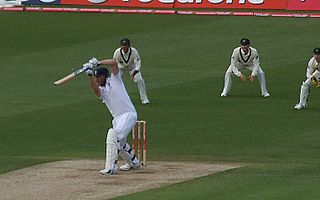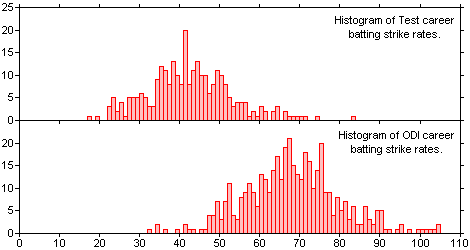
This is a general glossary of the terminology used in the sport of cricket. Where words in a sentence are also defined elsewhere in this article, they appear in italics. Certain aspects of cricket terminology are explained in more detail in cricket statistics and the naming of fielding positions is explained at fielding (cricket).

An all-rounder is a cricketer who regularly performs well at both batting and bowling. Although all bowlers must bat and quite a handful of batsmen do bowl occasionally, most players are skilled in only one of the two disciplines and are considered specialists. Some wicket-keepers have the skills of a specialist batter and have been referred to as all-rounders, but the term wicket-keeper-batter is more commonly applied to them, even if they are substitute wicket keepers who also bowl.
Cricket is a sport that generates a variety of statistics.

A partnership is a term used in cricket, that usually refers to the two batters and the runs they score together, including extras. Two batters bat in a partnership, although only one is a striker at any time. The partnership between two batsmen will come to an end when one of them is dismissed or retires, or the innings comes to a close, usually due to victory being achieved, a declaration, a time or over limit being reached, or the match being abandoned. In exceptional cases, if one of the original batters are injured, a player may run between the wickets on behalf of the injured batter. However, any runs scored by the injured batter will be recorded as being in the partnership of the two original batters. A partnership may also refer to two bowlers bowling from each end of the wicket.
In cricket, the batting order is the sequence in which batters play through their team's innings, there always being two batters taking part at any one time. All eleven players in a team are required to bat if the innings is completed.

In cricket, the run rate (RR), or runs per over (RPO), is the average number of runs a batting side scores per over. It includes all runs made by the batting side in the innings to that point of the game, both the runs scored by the batsmen and extras conceded by the bowling team.
In cricket, a players' batting average is the total number of runs they have scored divided by the number of times they have been out, usually given to two decimal places. Since the number of runs a player scores and how often they get out are primarily measures of their own playing ability, and largely independent of their teammates, batting average is a good metric for an individual player's skill as a batter. The number is also simple to interpret intuitively. If all the batter's innings were completed, this is the average number of runs they score per innings. If they did not complete all their innings, this number is an estimate of the unknown average number of runs they score per innings.

In cricket, a bowler's economy rate is the average number of runs they have conceded per over bowled. In most circumstances, the lower the economy rate is, the better the bowler is performing. It is one of a number of statistics used to compare bowlers, commonly used alongside bowling average and strike rate to judge the overall performance of a bowler.





